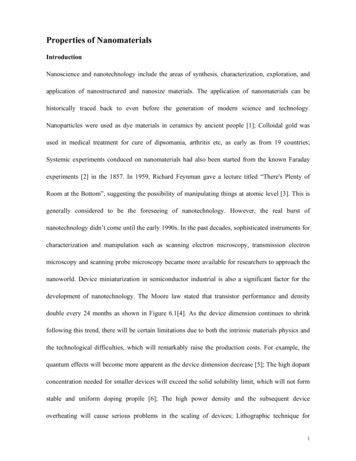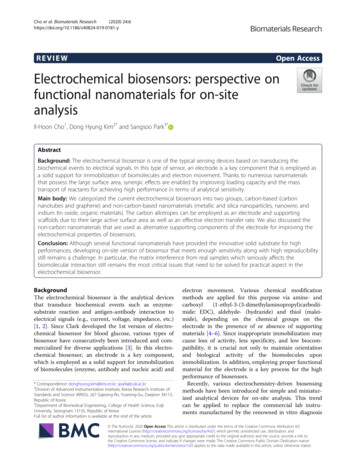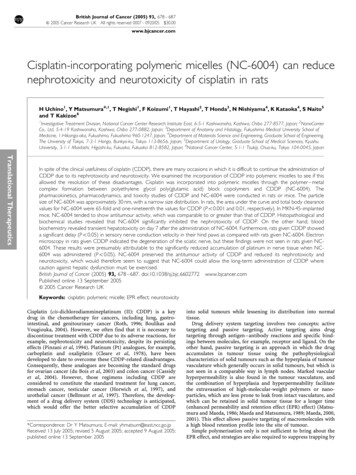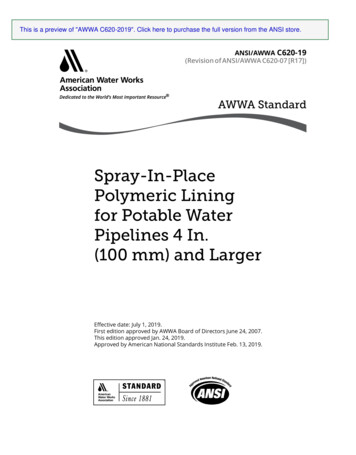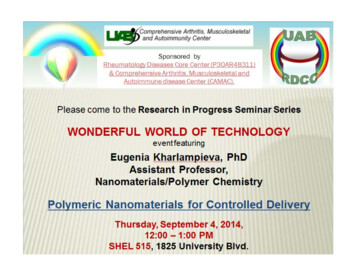
Transcription
4 µmPolymeric nanomaterials for controlled deliveryEugenia KharlampievaDepartment of ChemistryCenter for Nanoscale Materials & BiointegrationUniversity of Alabama at Birmingham, Birmingham, AL, USAhttp://www.kharlampievagroup.com/1
http://www.uab.edu/cas/chemistry/Excellent research opportunities in Polymer Synthesis Polymer Thin Films and Devices Biomimetic and Biopolymer Materials Inorganic Polymers Metallocrown Ethers Nanocrystals Matrix Assisted Laser Desorption PhotophysicsSpectroscopy (MALDI) Coordination Compounds Nonlinear Optical Materials Electron Transfer Reactions Biochemistry and Spectroscopy NMR Spectroscopy Quantum Chemistry Main Group Inorganic Synthesis DNA Microarrays Drug Design Chemical Education
Nanostructured functional polymeric coatings and containers1Encapsulated cells to protect fromimmune injury for transplantation100 µm
Islet transplantation for diabetes treatmentHubert Tse, MicrobiologyTony Thompson, Surgery, UABDiabetes Research CenterType I Diabetes:Islet-reactive immune cells destroyinsulin-producing β-cells T cells release inflammatorycytokinesMacrophage- and T cell-produceROS inducing inflammatorycytokine synthesisDisease treatment:Transplantation of insulin-producingpancreatic islets Modulation of immunogenicreactionsStabilization of islets morphologyand functionality100 µmHuman pancreatic islets - Isolated ‘microorgans’Ann. N. Y. Acad. Sci. 2013, 1281, 16; Diabetes, 2011, 60, 21444
Hydrogen-bonded layer-by-layer coatings for encapsulation of isletsMultilayer filmsTannic Acid (TA)- Rich in phenolic content- H-bonding 2 pH 9Fluorescently labeledPVPON* or PVCL*Poly(N-vinylpyrrolidone)(PVPON),Mw 1,300,000 g mol-1 Hydrophilic, anticoagulantproperties Non-charged, non-toxicKozlovskaya, Zavgorodnya, Chen, Ellis, Tse, Cui, Thomson, Kharlampieva, Adv. Funct. Mater. 2012, 22, 3389Chen, Kozlovskaya, Campos-Gomez, Saeed, Kharlampieva, Biomacromolecules 2013, 14, 38305
Layer-by-layer assembly on isletsN deposition cyclespolymer Bpolymer eReproducibleVersatile and flexibleEnvironmentally friendlyNo limitation on substrate shape or size6
Integrity and stabilityof the coating(PVPON/TA)4PVPON7nm/bilayer thickNHP, (PVPON-TA)4.5PVPON-AlexaCultured in Miami 1A, 25 C7
Viability and Function in vitroViability Assay: Propidium iodide (red-dead)/fluoresceine diacetate (green-live)Non-coated control4.5 bL -coatedViable for atleast 96 hFunctioning: Glucose-stimulated insulin secretion (GSIS)o Static incubation inMiami Medium 1A at25 Co Coated islets preserveβ-cells functioning forat least 96 hours invitroo Crucial requirementfor islet shipping andtransplantation8
Cytoprotective (PVPON/TA) capsules(PVPON/TA)4 HOo Macrophages and T cells can killislets by releasing theproinflammatory cytokineso Synthesis of cytokines byactivated macrophages and T-cellsin the presence of capsulesOOO HOOHHOHOHOOOOHOHOOHOHpoly(N-vinylpyrrolidone)Adv. Func. Mater. 2012, 22, 3389OHOOHpoly(N-vinylcaprolactam)
Immunomodulatory properties of (PVPON/TA) capsules60(PVPON/TA)4 capsules4-folddecreasein IFN-γsynthesispH 7.2Miami M1IFN-gamma, ng/mL50403020**10TBonecellsmarrowderived withstimulatedmacrophages(LPSBDC-2.5mimotopefrom E.Coli)0hells-m/-s181512IL-12p70, pg/mLo The activated T cells (adaptive immune response)and macrophages (innate immune response) cocultured with capsuleso Suppression of lymphocyte maturation factor (IL12p70) and interferon-gamma (IFN-γ) synthesis ascompared to capsule-free mediao Suppression is controlled by capsule amounto Capsules are not immunogeniclsellsellsshel8) sh8) sh m/0011(1x(1x-m/ m/ 910-folddecrease inIL-12p70synthesis6**3**0llsllsllsllslls/-she LPS/-she 0 8) she 0 8) she 0 8) she111-LPS xxx15/ (1/ (0. LPS/ (-LPS LPS10
SummaryHydrogen bonded TA-containing multilayer is an effective material for prolongingislet viability and function: Conformal coverage of the entire islet surface Stable for at least 7 days in vitro Nontoxic and non-immunogenic Prolonged islet functionality Versatile: Can be applied to rat, NHP, and human islets Suppresses synthesis of pro-inflammatory cytokines involved inmodulation of both innate and adaptive immune response in vivo Can be easily modified Scavenges ROS and RNS Tackles islet transportation and transplantation issuesXX XXXX11
Nanostructured functional polymeric coatings and containers2Stimuli-responsive shapedhydrogels for controlled delivery
Shaped ultrathin multilayer capsules for drug deliverySiO2DOX - LoadedMnCO33 µmSiccoredissolutionSiSiLiang et al. Chemistry of Materials 2012, 24, 3707Kozlovskaya et al. ACS Macro Letters 2012, 1, 384Chen et al. Biomacromolecules 2013, 14, 3830Kozlovskaya et al. ACS Nano 2014, 8, 5725Liu at al. Soft Matter, in print
pH-Triggered responses in cubical PMAA-based microcapsulesCH3nmH2C(PMAA)OHOOCOHCOOHC OC ONHNHRRNHC OC n*H2NHC OC ONHC OC OC ONHNHNHRRNHC ONHC ORNHC O(PMAA)nhydrogel capsulesKozlovskaya, et al. Soft Matter, 2012, 8, 9828Kozlovskaya, et al. ChemComm ,2011, 47, 835pHRNHC O(PVPON-PMAA)nhydrogel capsules14
pH-induced shape switch in cubical (PMAA) microcapsulesMnCO3 templates coated with (PMAA)20multilayer hydrogelsTemplate dissolution3 umpH 8pH 5Δ pHKozlovskaya, Higgins, Chen, Kharlampieva, ChemComm 2011, 47, 8352.
pH-induced responses of cubical (PMAA/PVPON)5 microcapsulesPVPON-NH2-8PMAAOHOCEDC C n*HCHCH3 2pH 8pH 4.5-54 μm4 μmC OC OC ONHNHNHRRRNHNHNHC OC OC OSwelling ratio is 1.4(DpH 8/DpH 5)Polymer contour length between the neighboring cross-links to the persistence polymer length:L/lp (PMAA)20 L/lp (PMAA-PVPON)510-fold difference suggesting a more rigid system in the case of (PMAA-PVPON)nKozlovskaya, Wang, Higgins, Chen, Chen, Kharlampieva, Soft Matter, 2012, 8, 9828.
pH-response of spherical capsules: (PMAA) vs (PMAA-PVPON)3.3 µm3pH 44.19 µm361.9 µm3(PMAA)Size increase: 2.5-foldVolume increase: 19-foldpH 7.59.96 µm3(PMAA-PVPON)Size increase: 1.4-foldVolume increase: 2.4-fold
pH-Induced change in aspect ratio from discs to oblate ellipsoidspH 7.4Silicon templatesHpH 4L600 nmHLL/H 1h3 µm3 µmDiameter/height,L/HSolution pH(PMAA)15(PMAAPVPON)5VolumechangepH 7.4pH 4pH 7.4 to 43.5 0.32.8 0.324-fold5.2 0.73.0 0.32.3
Shape-Dependent Cellular Internalization: Spheres vs Discs4T1 breast cancer cellsincubated for 24hSphericalcorescapsulesMacrophage J774A.1 and endothelial HMVEC cellsCoressphericalSpheric discoidalalMinimized phagocytosisand interactions withendothelial cells ofcapsules compared toCapsulessolid particles - longer circulation timesDiscoidalcorescapsulesSpherical and discoidalcapsules decreased 2-fold insize upon internalization byHMVECs and 4T1 cells - controlled release in in theearly endosomes of pH Breast cancercellsKozlovskaya, Alexander, Wang, Kuncewicz, Liu, Godin, Kharlampieva, ACS Nano 2014, 8, 5725
Capsules with Enhanced Structural Stability in Dry StateTannic acid, TAR:Intra-molecular H-bondsInter-molecular H-bondsPoly(N-vinylpyrrolidone),PVPONPVPONcoreTA Stable at physiological pHAntioxidant propertiesImmunomodulatory capabilityAntibacterial propertiesCoredissolutionChen, Kozlovskaya, Goins, Campos-Gomez, Saeed, Kharlampieva, Biomacromolecules 2013, 14, 3830.Kozlovskaya, Zavgorodnya, Chen, Ellis, Tse, Cui, Thompson, Kharlampieva, Adv. Func. Mater. 2012, 22, 3389
Effect of Wall Thickness on Particle ShapeTannic acid (TA) / Poly(N-vinylpyrrolidone) (PVPON)Chen, Kozlovskaya, Goins, Campos-Gomez, Saeed, Kharlampieva, Biomacromolecules 2013, 14, 3830.
Effect of Wall Thickness on (PVPON/TA)n ShapeHemispheres are produced when 15 n 20 the ratio of the shell thickness (t) tothe particle diameter (D) lies in theregion from t/D 0.041 to t/D 0.055Hollow particles maintain their threedimensional shapes in the dry if n 25.5The LbL shell deformation depends on the shell stiffness, k, which depends on: Young’s modulus, E 600 MPa in dry state (vs 1 GPa for (PMAA/PVPON)) Shell thickness, t Capsule radius, r Poisson ratio, νGao et al. Eur. Phys. J. E 2001, 5, 21Kӧhler et al. Macromolecules, 2004, 37, 9546Elsner et al. Soft Matter, 2006, 2, 966
Formation of HemisphereswatertD(PVPON/TA)15.5hollow multilayercapsules in DI waterdryingSAfter being dried
Shape-Dependent Cellular Internalization: Spheres vs HemispheresNumber of particles per cellCLSM of THP-1macrophagecells withinternalized(PVPON/TA)15.5Uptake of thehemispheres percell is two timesmore efficientJ. Chen, V. Kozlovskaya, A. Goins, J. Campos-Gomez, M. Saeed, E. Kharlampieva, Biomacromolecules 2013, 14, 3830
Effect of Wall Thickness on Particle ShapeHollow cubes at n 25 bLChen, Kozlovskaya, Goins, Campos-Gomez, Saeed, Kharlampieva Biomacromolecules 2013, 14, 3830
Hydrogel Cubes for Drug Storage and pH-Triggered ReleaseKozlovskaya, Chen, Tedjo, Liang, Campos-Gomez, Oh, Saeed, Lungu, Kharlampieva, J. Mater Chem B, 2014, 2, 2494;(Emerging Investigators themed issue)
Shaped Porous TemplatesMnCO3MnCO3Mn2O3Mn2O3Zeta-potential, mV-50-40-30-20-100pH 3.6manganesecarbonatemanganeseoxide10024Particle size, umHighlynegativenet surfacechargeParticlesAverageSurface AreabPorePore Sizea(m2 g-1)Volumec(cm3 g-1)(nm)2 µm cubic4417.5 0.40.192 0.0024 µm cubic4017.5 0.50.175 0.0042 µm spherical4319.3 0.50.205 0.005Large average pore sizeWith Dr. Lungu, UAB
Hydrogel Particle Structure: Dry vs in Solution21 kDa PMAA360 kDa PMAA21 kDa PMAA360 kDa PMAACLSMKozlovskaya, Chen, Tedjo, Liang, Campos-Gomez, Oh, Saeed, Lungu, Kharlampieva, J. Mater Chem B, 2014, 2, 2494;SEM
pH-Responsive Cubic Hydrogels for DOX deliveryDoxorubicin loaded at pH 7.2 released at pH 5pH 53.64(c)µm cubic3.2Size, umpH 7.4 DOX-DOX2.82.421 kDa360 kDa2.01.634567pH8Viability of A549 and HeLa cancer cells decreased to 60% after72 h of incubation with 2-µm DOX-loaded hydrogel cubes
AcknowledgmentsKharlampieva GroupDr. Veronika KozlovskayaDr. Alejandra EspinosaPatrick Alford, Xing Liang, Will Higgins,Oleksandra Zavgorodnya, Jun Chen,Fei Liu, Bing Xue, Shahriar Habib,Srikanth Medipelli, Miranda TrentleCollaboratorsHubert Tse, Microbiology, UABTony Thomson, Surgery , UABKenneth Hoyt, Radiology, UABMohammad Saeed, Southern Research Institute, ALhttp://www.kharlampievagroup.com/Robert Galemmo, Southern Research Institute, ALClaudiu Lungu, Environmental Health Sciences, UABBiana Godin, The Methodist Hospital Research Institute , TXJohn Ankner, Oak Ridge National Lab, TNFundingNSF DMR Polymers CAREERNSF DMR BiomaterialsNIH PSOC Outreach PilotDOD U.S. Army Corps of EngineersUAB Faculty DevelopmentNIH NIBB P30UAB Chemistry Start-up FundsThank YOU !30
Tony Thompson, Surgery, UAB Diabetes Research Center . Tannic Acid (TA) - Rich in phenolic content - H-bonding 2 pH 9 Hydrogen-bonded layer-by-layer coatings for encapsulation of islets Multilayer films Poly(N-vinylpyrrolidone) (PVPON), M w- 1,300,000 g mol 1 Hydrophilic, anticoagulant







